Onions are the third largest fresh vegetable industry in the USA. Onions are one of the most widely adapted vegetable crops. They can be grown in subtropical areas from the tropics. This adaptation is mainly due to the different responses of day length. Unlike most other species, day length affects bulbing in Onions, unlike flowers. Let’s check out how to start Onion farming in the USA.
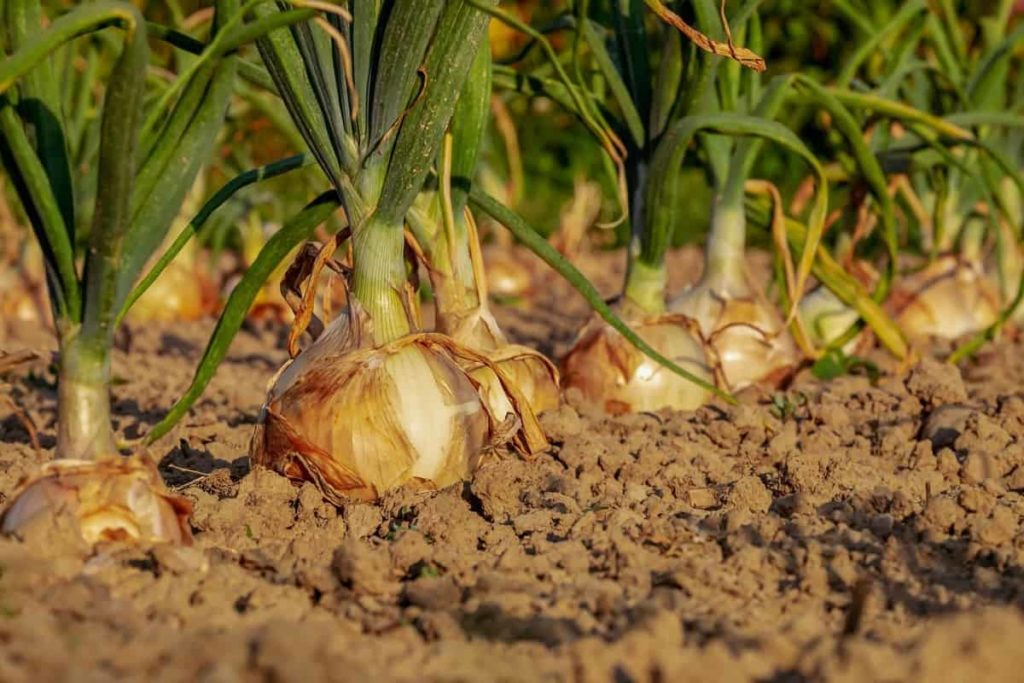
How to start onion farming in the USA
Onion-cultivated areas in the USA
Producers and some productive areas (e.g., South Texas, California Valleys, Vidalia, Georgia, Walla Walla, Washington, New Mexico, etc.) trademark their brands and labels. The four largest production areas are Washington, Idaho-Eastern Oregon, California, and West Central Oregon. In Washington, dried Onion production is concentrated in the fertile Columbia Basin, north of three cities.
The Snake River Valley, from western Idaho to eastern Oregon, is the most concentrated area of dried Onions in the United States, shipped from August to March or April. In California, Onions are planted for shipping from April to August. The National Onion Association reports that five more states deliver more than 100 million: New Mexico, New York, Nevada, Texas, and Colorado.
US Onion production and availability
Onions were first brought to the USA by early European settlers. Onions were adapted to the temperate climate conditions throughout the Northeast, where the first European settlements occurred. Varieties from the tropical Mediterranean region eventually traveled to the southeastern United States. The size of Onion production depends on the type of seed sown. There is a difference in the size and weight of the product according to the type of seed.
On average, a healthy Onion plant produces 80 grams in size and weight of Onion (the green part not included). The Onion should be grown on well-drained soils with high organic matter content, a good water infiltration rate, and a moisture retention capacity. The soil should not be compacted for growing Onions, and the pH level should be 5.8 to 6.6. Sandy loams and dung soils are often used for Onion farming. Soils with low sulfur levels (less than 40 ppm) are recommended for sweet Spanish Onion farming.
Onion farming in California
California is a major producer of American unions. California is a major force in the US Onion market. California also grows Onions for seed. The Imperial and Sacramento valleys are major centers for seed production. The largest Onion producer in the USA is California, and it is the only state that produces both spring and summer Onions. Other major producers of summer-grown Onions are Washington and Oregon. About 16% of California’s Onions are harvested in the spring.
In case you missed it: Top 18 Steps/Ways to Boost Onion Yield: How to Increase Production, Size, and Quality
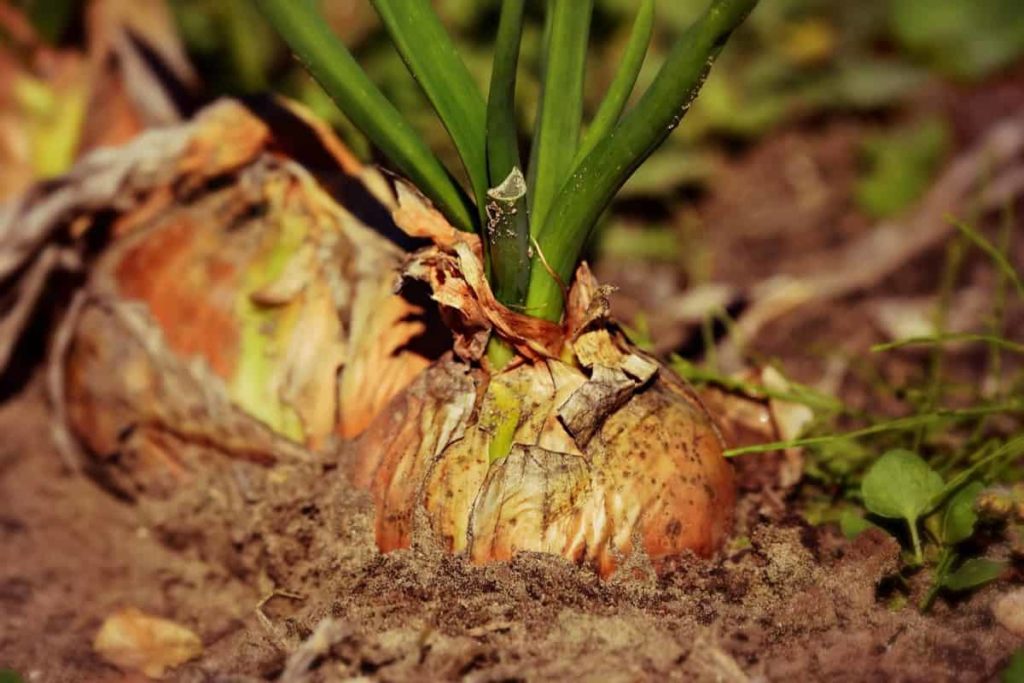
California produces 42% of the nation’s spring Onion crop, with Georgia and Texas being the other major producers. About half of California Onions are cultivated for the fresh market and about half for processing. The ratio of spring, summer, fresh, and processing Onions is stable. Yields of spring-harvested Onions in California are significantly higher than average in Texas and Georgia, the other major producers. For summer-harvested Onions, yields in the Pacific Northwest exceed those in California.
Onion bulbing is primarily driven by photoperiod or day length. Both long-day and medium-day Onion varieties are recommended for the northeastern United States. Onions are also divided by skin color (red, white, brown, or yellow), flavor (sweet or pungent), and bulb shape (round, flat, or globe). Based on the report from the University of California, Davis, California is the largest producer of Onions in the US (including fresh and processed) and the only state to produce spring and summer harvested Onions.
Approximately California produced 31 percent of the nation’s total Onion crop. About 16% of California’s Onion harvest is done in the spring, and the state produces 42% of the nation’s spring Onion crop. According to the report, about half of California’s Onions are grown for the fresh market and about half for processing.
The proportion of spring, summer, fresh, and processed Onions is stable. Onions are grown throughout California. In a recent census, the counties with the most Onion acreage were Fresno, Imperial, Kern, Siskiyou, and San Joaquin, with over a third of the state’s acreage in Fresno County. Los Angeles County also includes the high desert region of the Antelope Valley and the fresh Onion market in the Salinas Valley.
Different Onion varieties in the USA
Onions are also classified according to their purpose (fresh market or dehydrator). Fresh Onions are mostly short and medium days. They are harvested by hand and processed either freshly or lightly for products such as Onion rings. They are sweeter and have a lower dry matter content (5-12%).
In case you missed it: How to Start a Backyard Garden from Scratch: A Step-By-Step Guide for Beginners
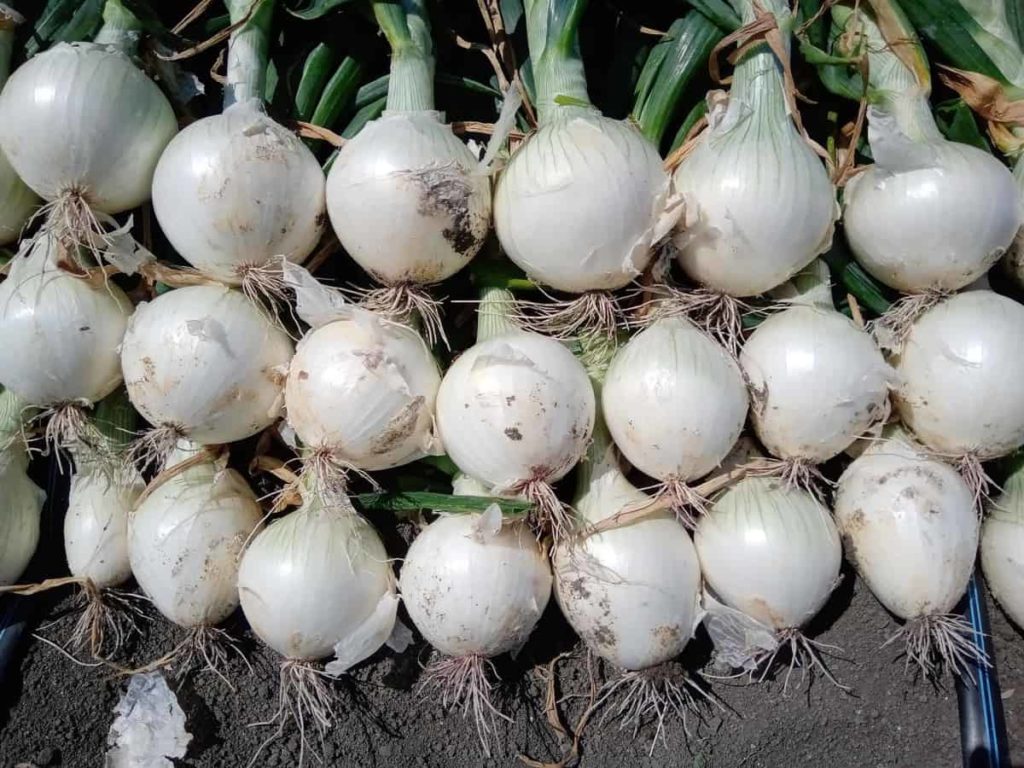
Short-day varieties are often harvested at maturity and are not stored. Dehydrated Onions, which can last less or more days, contain faster and more dry substances (15-25%). Their crop is mechanized. Both fresh and dehydrator varieties are grown throughout California.
Yellow Onions
Yellow Onions are full-flavored, and the most popular type – about 87% of the Onion crop in the USA is yellow Onions. Yellow Onions are a staple vegetable in the family kitchen or restaurants across the United States. It demonstrates the ability to produce yellow Onions in various food services, from Onion flowers to wonderful dishes. Wada Farms can help you increase your profit potential with some of the best yellow Onions available in the United States – discover the difference.
Red Onions
Nothing makes the dish pop like the vibrant, strong beauty of the red Onion. Red Onions have gained popularity in both consumer and food services markets due to the color and texture of the plate’s overall offering. On the one hand, red Onions produce a crispy, light Onion flavor that can enhance the flavor of any dish. Whether it’s a food service or a retail application, we can take your red Onion category to the next level – let’s show you a lot of possibilities.
White Onions
White Onions are a strong contender for one of the most popular Onions in cooking but are also used in fresh forms. White Onions are very popular in many cuisines, especially in Mexican and Southwestern cuisines, with a flavor profile that produces a tangy but subtly sweet-tasting profile. Over the years, Wada Farms has purchased some of the best growers in the country to develop an accurate white Onion program that will ensure consistent quality, supply, and, most importantly, a satisfied customer.
Brown Onion
Characteristics: With round, thin, brown papery skin, Brown Onions are the most common Onion type in the United States and easily the most versatile cooking Onion. Popular varieties include Brown Onions and slightly larger, slightly sweeter Spanish Onions.
Varieties of Onions according to season
Spring/Summer Onions
- Yellow, red, and white from March to August.
- Recognizable by their thin, light-colored skin.
- Usually, they have a high water content, which shortens their shelf life and makes them more susceptible to bruising.
- Sweet to mild in taste.
- Best used in salads, sandwiches, and fresh, lightly cooked, or grilled dishes.
- Many specialties, sweet Onions are part of this category and are sold under a specific trade name or label.
- Some domestic and all imported Onions with these characteristics are offered at other times.
Autumn/Winter Onions
- Available from August to April in yellow, red, and white.
- They are easy to recognize by their multiple layers of thick, dark-colored skin.
- Generally low in water content, they have a long shelf life.
- Mild to spicy flavor, perfect for savory dishes that require more cooking time or flavor.
In case you missed it: How To Start Onion Farming, Questions, Answers
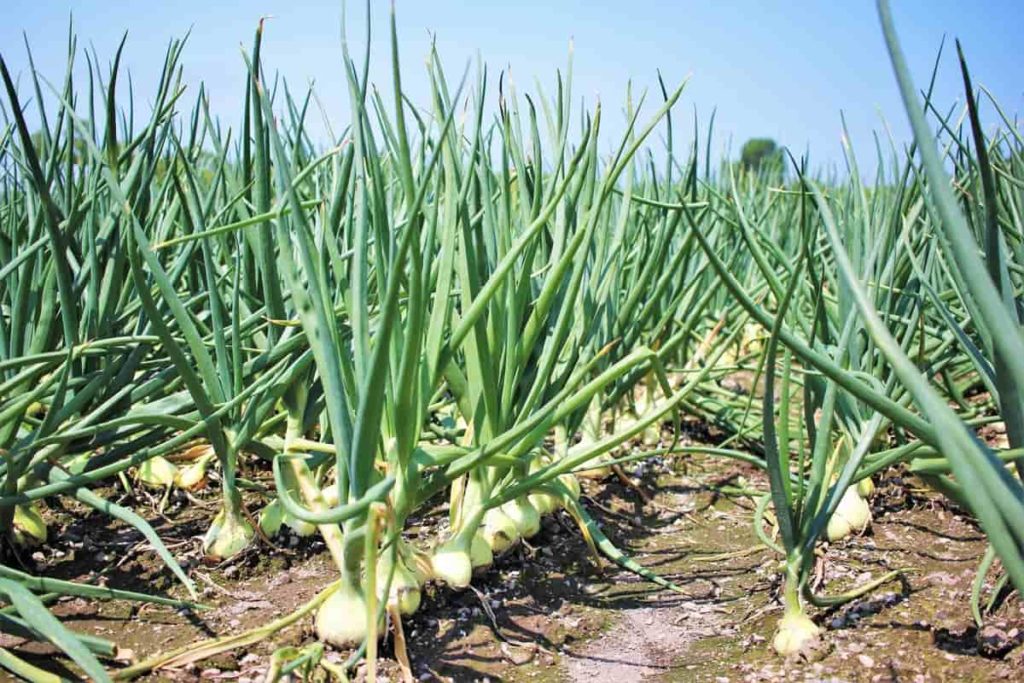
Soil management in Onion farming in the USA
Onions grow best in fertile and well-drained soils. However, most sandy loam, sandy loam, or sandy soil will benefit sweet Onion production. These soils are low in sulfur, allowing for greater flexibility in sulfur management for Onion production. Avoid soils with heavy clay content. Loamy soils are high in sulfur, which can cause Onions to rot. Extremely sandy soils are more difficult to manage because they require more fertilizer and water.
Fertilizer requirements should always be based on a recent, properly obtained soil sample. Contact your local county extension office or crop consultant regarding proper soil sampling procedures and results interpretation. Obtain a soil sample a few months before crop establishment to determine lime requirements and make timely lime applications.
If soil test results show a pH less than 6.0, apply dolomitic lime and disc two to three months before land preparation to bring the pH to the optimum range of 6.2 to 6.5. Adequate liming is necessary to keep the soil pH above 6.0. Low pH levels can cause nutrient deficiencies during the growing season. Also, high rates of fertilizer used in Onion production cause the pH level to drop during the growing season.
If the pH level is not corrected during the Onion season, nutrient deficiencies can occur throughout the year, and yield may decrease. Even soil tests indicate adequate levels; calcium and phosphorus deficiencies are often associated with low pH. However, phosphorus deficiency can be difficult to correct during the growing season due to low pH.
Fertilizer requirement for Onion growth in the USA
Onions require more fertilizer than most vegetable crops because plant bed and dry bulb Onion fertilization should be considered. They respond well to additional fertilizer 40 to 60 days after sowing or transplanting. Manure application is crucial to achieve maximum yield, with multiple applications ensuring good yields. It will increase the plant’s fertilizer and reduce the amount lost through leaching.
More recent research, however, indicates that good results can be obtained by using as few as three fertilizers. Pre-plant fertilization will vary with natural fertility and harvest date. For commercial Onion cultivation, irrigation is necessary at the time of transplanting/doubling cloves, and then light irrigation is required on the third day of planting. Water the transplants immediately after planting.
Apply well-rotted farmyard manure @ 200-300 quintals, nitrogen @ 60-150 kg, phosphorus @ 35-150 kg, and potassium @ 25-120 kg per hectare depending on soil test, cultivar and growing season. Farmyard manure for the Onion crop is applied during field preparation. Apply 50% nitrogen and full phosphorus and potash before transplanting or planting bulbs. The remaining half of nitrogen is top-dressed 5-6 weeks after transplanting.
Irrigation requirement for Onion farming
Immediately after transplanting, irrigation is given according to the needs and critical stages of the crop. Irrigation should be stopped 15-20 days before the bulbs are uprooted or maturation begins. Onions need very careful and frequent irrigation as it is a shallow-rooted crop. The need for water decreases during the early development of the crop and increases later in the growing stages. Irrigation should occur 10-15 days in cold and one week in hot weather.
In case you missed it: Growing Spring Onions – Farming Tips, Ideas, Secrets
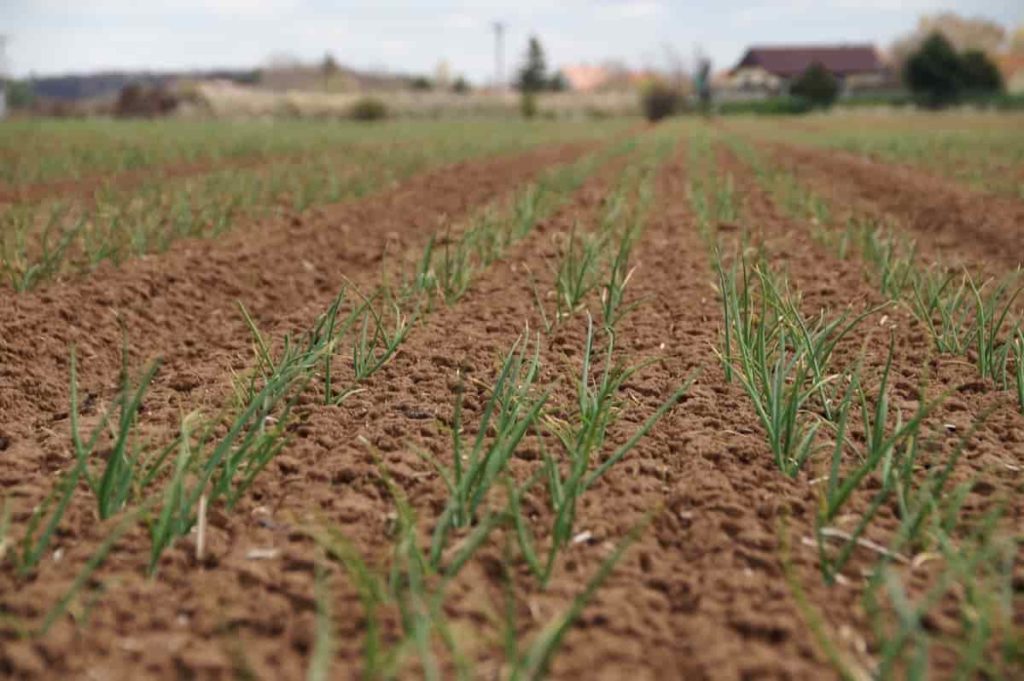
Bulb formation and bulb growth stages (70-100 days after transplanting) are important for water needs. Insufficient moisture slows down the bulb’s growth, while over-supply causes rot. A dry spell can cause the outer scales to split. Usually, 10-12 irrigations are given in the Rabi season. When the peaks mature and start falling, stop irrigating. Onion boards usually require less care and other management. However, taking extra care will help the plants grow well.
Pest management in Onion farming
Weed management in Onions can be achieved with a good herbicides, cultivation, and crop rotation system. Depending on the specific problem of the weed and the stage of development of the Onion, many preplant and later herbicides are available for the Onion. If the infection level is mild, early planting can reduce weed problems. Pests can be the main problem in Onion farming. Thrips and Onion maggots have the potential to reduce crops in any year.
Allium leaf miner problem is a new invasive worm in Onions in Pennsylvania. Monitoring pest populations in Onion crops will help you find the best time to use pesticides and how often to spray. Numerous diseases can cause crop damage, especially bottom mildew, purple spots, and white rot. These plant diseases can be prevented using good crop circulation systems, high-quality soil with good ventilation, and disease-resistant Onion varieties.
Many pesticides needed to grow Onions are used sparingly and require a pesticide license to purchase. Pesticide application tests are conducted in extension offices. Contact the local office for dates and times. When using any pesticide in the enterprise, follow all label recommendations regarding application rates and personal safety equipment requirements. Remember that worker safety standards apply to both employers and employees.
Harvesting time for Onion farming in the USA
Pull off any bulbs that send up flower stalks. It means the bulbs have stopped growing. These Onions will not store well but can be used in recipes in a few days. Spring-planted Onions are ready to harvest by mid-summer. As the Onions ripen, the tops (leaves) turn yellow and fall off. Now, bend the tops downward or lean over the plants to speed up the final ripening process. Loosen the soil around the Onion bulb to encourage drying.
Sow in dry weather till late summer. Pull the Onions carefully when the tops are brown. Handle them carefully, as the slightest injury (now and in storage) will encourage rotting. Trim the roots, cutting the tops to 1 or 2 inches (but leave the tops if you plan to string the Onions together). Onion is harvested based on the purpose for which the crop is grown. The dry Onion crop is ready for harvesting in five months. However, for marketing as green Onion, the crop is ready three months after transplanting.
When the bulbs that develop from the Onion leaf bases are fully formed, the tops of the green leaves begin to turn yellow and eventually drop slightly above the top of the bulb, leaving the neck straight. The Onion bulbs are ready to harvest when the tops “go down” like this. Because not all Onions in a crop ripen simultaneously, large-scale commercial growers harvest them when about half of the tops are down.
In case you missed it: Hydroponic Onion Farming – Growing Guide
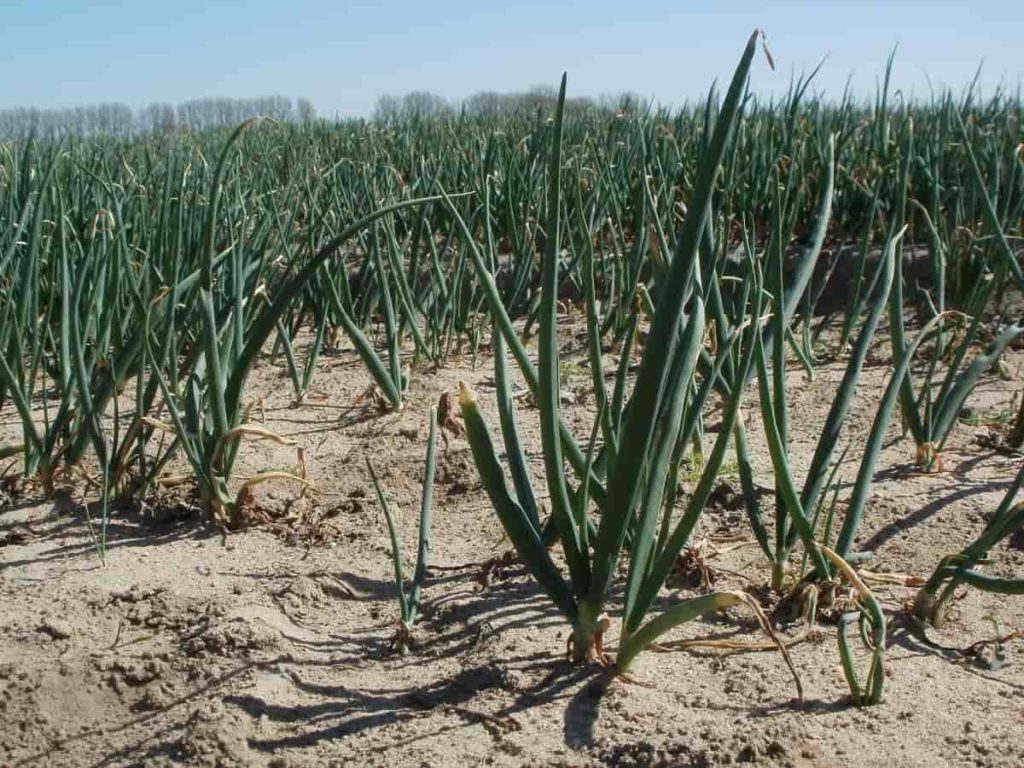
Onion marketing in the USA
Fresh market Onions are available in the northeastern United States from the first of July through the end of October. They are traditionally sold loose in large containers or mesh bags of varying weights. Several marketing methods are available to the Onion grower, like local retailers, wholesale markets, cooperatives, farmers’ markets, roadside stands, community-supported agriculture (CSA), pick-your-own operations, and processing firms.
When planning production, first consider your capacity and market access. If you did some market research — growers would overestimate their selling ability. In wholesale marketing, producers contract with shippers and ship Onions at a predetermined price. Send your Onions to the wholesale market; your product price fluctuates most.
Marketing cooperatives typically use the daily accumulated cost and value, which spreads price fluctuations across all participating producers. Local retailers are another potential market, but you should take the time to contact production managers and provide stores with good-quality Onions when needed. Depending on location, processors may or may not have marketing options.
Onion yield in the USA
US farmers grow about 125,000 acres of Onions yearly and produce about 6.75 billion yearly. It includes organic produce but not bulb Onions for dehydration.
Conclusion
Onions are the fourth most eaten fresh vegetable in the United States, after Potatoes, Tomatoes, and Sweet Corn. Americans are eating more Onions. It helps those Onions have natural properties that keep us free from food-borne diseases and healthy. The profitability of Onion cultivation depends on the quality, production, and market demand for Onion.
- Types of Pesticides Used in Agriculture: A Beginner’s Guide
- Economical Aquaculture: A Guide to Low-Budget Fish Farming
- 15 Common Planting Errors That Can Doom Your Fruit Trees
- How to Make Houseplants Bushy: Effective Tips and Ideas
- Innovative Strategies for Boosting Coconut Pollination and Yield
- Pollination Strategies for Maximum Pumpkin Yield
- The Complete Guide to Chicken Fattening: Strategies for Maximum Growth
- Natural Solutions for Tulip Problems: 100% Effective Remedies for Leaf and Bulb-Related Issues
- Revolutionizing Citrus Preservation: Towards a Healthier, Greener Future
- Natural Solutions for Peony Leaf and Flower Problems: 100% Effective Remedies
- Maximizing Profits with Avocado Contract Farming in India: A Comprehensive Guide
- Natural Solutions for Hydrangea Problems: 100% Effective Remedies for Leaf and Flowers
- The Ultimate Guide to Choosing the Perfect Foliage Friend: Bringing Life Indoors
- From Sunlight to Sustainability: 15 Ways to Use Solar Technology in Agriculture
- The Ultimate Guide to Dong Tao Chicken: Exploring from History to Raising
- The Eco-Friendly Makeover: How to Convert Your Unused Swimming Pool into a Fish Pond
- Mastering the Art of Delaware Chicken Farming: Essentials for Healthy Backyard Flocks
- 20 Best Homemade Fertilizers for Money Plant: DIY Recipes and Application Methods
- How to Craft a Comprehensive Free-Range Chicken Farming Business Plan
- Brighten Your Flock: Raising Easter Egger Chickens for Beauty and Bounty
- How to Optimize Your Poultry Egg Farm Business Plan with These Strategies
- Subsidy for Spirulina Cultivation: How Indian Government Schemes Encouraging Spirulina Farmers
- Ultimate Guide to Raising Dominique Chickens: Breeding, Feeding, Egg-Production, and Care
- Mastering the Art of Raising Jersey Giant Chickens: Care, Feeding, and More
- Ultimate Guide to Raising Legbar Chickens: Breeding, Farming Practices, Diet, Egg-Production
- How to Raise Welsummer Chickens: A Comprehensive Guide for Beginners
- How to Protect Indoor Plants in Winter: A Comprehensive Guide
- Ultimate Guide to Grow Bag Gardening: Tips, Tricks, and Planting Ideas for Urban Gardeners
- Guide to Lotus Cultivation: How to Propagate, Plant, Grow, Care, Cost, and Profit
- Agriculture Drone Subsidy Scheme: Government Kisan Subsidy, License, and How to Apply Online
- Ultimate Guide to Raising Araucana Chickens: Breed Profile, Farming Economics, Diet, and Care
- Bringing Hydroponics to Classroom: Importance, Benefits of Learning for School Students
- Ultimate Guide to Raising Polish Chickens: Breed Profile, Farming Economics, Diet, and Care
- Ultimate Guide to Raising Australorp Chickens: Profile, Farming Economics, Egg Production, Diet, and Care
- Silkie Chicken Farming: Raising Practices, Varieties, Egg Production, Diet, and Care
- Sussex Chicken Farming: Raising Practices, Varieties, Egg Production, Diet and Care
Hi
I am from Afghanistan and just started onion growing in my own lands of at least one acre.
I am now trying to make coldstorage plz inform me about your experience